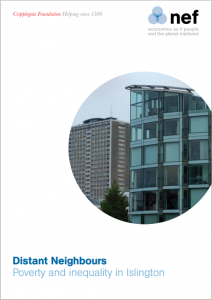
This report was conducted on Islington, an area of London where the gap between the wealthy and the poor is stark, and forecast to become more so by 2020. The opening paragraph describes the context: five years of economic uncertainty, public sector cuts and welfare reform. Could this place be interchangeable for almost any other developed country?
Through interviews with both high and low income earners in Islington, analysis of statistical trends, they explore the changing nature of poverty in Islington, inequality in Islington, forecast what it will be like there by 2020 and identify key areas for action.
What struck the lead researcher the most was the finding that it …”was not how hard people find it to get by or how fast the cost of living is rising. It was how living with inequality affected rich and poor residents alike. How uncomfortable, unhappy and less like a community they felt.”
“In contrast to its image of boutique shops, top-end restaurants, and a thriving night life, Islington has long been a borough of entrenched poverty and wide inequalities. In 2008, Cripplegate Foundation’s report Invisible Islington painted a rich picture of the lives of the borough’s lower-income residents. It showed how people were struggling with worklessness, debt, social isolation, and poor physical and mental health.”
Their key findings:
- Poverty is intensifying in Islington
- Middle-income families have been squeezed out of Islington
- By 2020, only the wealthiest will be able to afford to live in Islington
Their three broad areas for action identified:
- Make a difference today
- Invest upstream to prevent poverty and inequality
- Advocate for change beyond Islington
Find the report here
